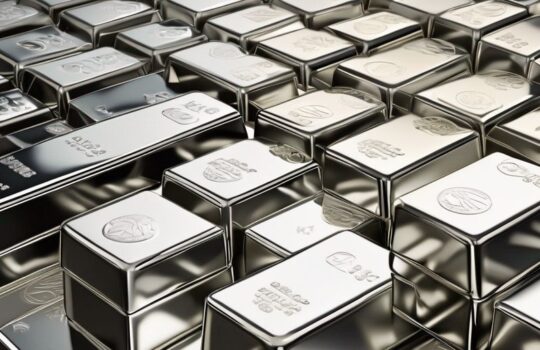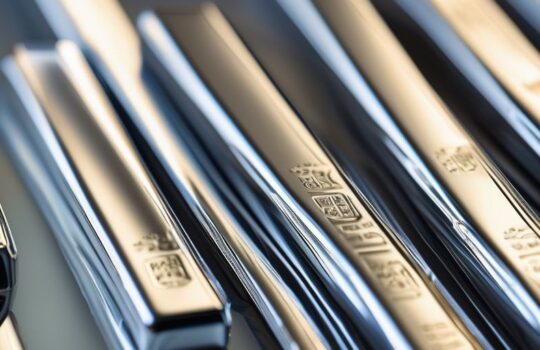Introduction
Investing in precious metals has long been considered a safe and lucrative option for investors. In this blog post, we will explore the two most popular precious metals – gold and silver – and analyze their historical performance as investment assets. Understanding the factors that affect the prices of these metals is crucial for making informed investment decisions in 2023. By delving into the past trends and examining the current market conditions, we can gain valuable insights into which metal may be the better choice for your investment portfolio. So let's dive in and explore the world of gold and silver investing!
Historical Performance of Gold and Silver
Gold's historical performance
Gold has long been regarded as a safe haven asset, sought after by investors during times of economic uncertainty. Its value is not tied to any specific currency or government, making it a reliable store of wealth. Over the years, gold has shown remarkable price stability and consistent growth.
Analyzing gold's price trends reveals its resilience as an investment option. During periods of economic downturns or market volatility, gold prices tend to rise as investors flock to this precious metal for security. Conversely, during times of economic prosperity, gold prices may experience a temporary decline.
Several factors influence gold's performance in the market. These include global geopolitical tensions, inflation rates, interest rates, and central bank policies. For example, during times of political instability or when there are concerns about inflation, the demand for gold tends to increase, driving up its price.
Silver's historical performance
Silver differs from gold in that it has both industrial and investment demand. While silver is also considered a safe haven asset like gold, its value is influenced by factors beyond just investor sentiment. The industrial applications of silver make it susceptible to fluctuations in supply and demand.
When comparing silver's price movements with that of gold, we can observe some similarities but also notable differences. Silver tends to be more volatile than gold due to its smaller market size and higher industrial usage. During periods of economic growth and increased industrial activity, silver prices may experience greater upward momentum compared to gold.
Factors impacting silver's performance include industrial demand from sectors such as electronics and solar energy production, mining production levels, investor sentiment towards precious metals as a whole, and macroeconomic conditions affecting global trade.
Understanding the historical performance of both gold and silver provides valuable insights into their potential as investment options in 2023. By considering these factors alongside other key indicators discussed later in this blog post, investors can make informed decisions about which precious metal aligns best with their investment goals and risk tolerance.
Factors Affecting Prices in 2023
Macroeconomic factors
Several macroeconomic factors play a significant role in influencing the prices of precious metals like gold and silver. Inflation and interest rates are two key factors to consider. When inflation rates rise, the value of fiat currencies tends to decline, leading investors to seek refuge in assets like gold and silver. Similarly, changes in interest rates can impact the opportunity cost of holding precious metals versus other investments.
Global economic conditions also have an impact on precious metal prices. Economic growth or recession, trade policies, and fiscal stimulus measures implemented by governments can all affect investor sentiment towards these metals. Additionally, geopolitical tensions such as conflicts or political instability can drive up demand for safe-haven assets like gold and silver.
Supply and demand dynamics
The supply and demand dynamics of gold and silver are crucial factors affecting their prices. Mining production and exploration levels directly influence the available supply of these metals. Any disruptions or changes in mining operations can impact the overall supply chain.
On the demand side, industrial and technological applications play a significant role in determining the price movements of silver. Silver is widely used in various industries, including electronics, solar energy production, medical devices, and more. Changes in industrial demand can lead to fluctuations in silver prices.
Investor sentiment and demand also contribute to price movements. The perception of gold and silver as safe-haven assets during uncertain times drives investor interest. Increased buying or selling activity from institutional investors or retail investors can influence market trends.
Currency fluctuations
Currency movements have a direct impact on precious metal prices. As major currencies fluctuate against one another, it affects the relative value of gold and silver when priced in different currencies. For example, if the US dollar weakens against other major currencies, it typically leads to higher gold prices since it becomes relatively cheaper for holders of other currencies.
Central bank policies also play a role in currency fluctuations and subsequently affect precious metal prices. Monetary policy decisions such as interest rate changes or quantitative easing measures implemented by central banks can influence investor confidence in fiat currencies versus tangible assets like gold and silver.
Considering these macroeconomic factors, supply-demand dynamics, and currency fluctuations is essential for understanding how they may impact the prices of gold and silver in 2023. By staying informed about these variables alongside expert opinions discussed later in this blog post, investors can make more informed decisions about their precious metal investments.
Comparison of Gold and Silver as Investment Options
Investment characteristics of gold
Gold has long been recognized as a reliable store of value and a hedge against inflation. Its scarcity and limited supply make it an attractive option for investors looking to preserve their wealth over the long term. During periods of economic uncertainty or high inflation, gold prices tend to rise, providing a potential safeguard against the erosion of purchasing power.
Gold also offers portfolio diversification benefits. As an asset with low correlation to traditional financial markets, it can help offset losses during market downturns. Including gold in a diversified investment portfolio can potentially reduce overall portfolio volatility and enhance risk-adjusted returns.
In terms of liquidity and accessibility, gold is highly liquid and widely traded around the world. It can be easily bought or sold through various channels such as bullion dealers, jewelry stores, or online platforms. The global market for gold ensures that investors can enter or exit positions with relative ease.
Investment characteristics of silver
Silver possesses unique investment characteristics that set it apart from gold. While silver is also considered a store of value and a hedge against inflation, its industrial applications give it additional value beyond its role as a precious metal.
The industrial demand for silver stems from its use in electronics, solar panels, medical devices, and various other sectors. This industrial demand provides support for silver prices and creates the potential for price appreciation when industries experience growth or technological advancements.
However, it's important to note that silver tends to exhibit higher volatility compared to gold due to its smaller market size and industrial usage. This volatility can present both opportunities and risks for investors. While silver may offer greater upside potential during bullish periods, it may also experience sharper price declines during market downturns.
Investors considering silver should carefully assess their risk tolerance and investment objectives before allocating funds to this precious metal.
By comparing the investment characteristics of gold and silver, investors can evaluate which metal aligns best with their investment goals and risk appetite. Both metals have unique qualities that make them valuable additions to an investment portfolio, but understanding their differences is crucial in making informed decisions about precious metal investments in 2023.
Expert Opinions and Predictions for 2023
Expert opinions on gold
Many experts have provided forecasts and opinions on the potential performance of gold in 2023. While it is important to note that these predictions are subject to market fluctuations and unforeseen events, they can still provide valuable insights for investors.
Forecasts on gold prices in 2023 vary among experts. Some predict a continuation of the upward trend, citing factors such as ongoing economic uncertainty, geopolitical tensions, and potential inflationary pressures. These experts believe that gold's safe-haven status will continue to attract investors seeking stability and wealth preservation.
Factors influencing experts' predictions include macroeconomic indicators such as interest rates, inflation rates, and central bank policies. Additionally, global geopolitical developments, trade tensions, and the overall health of the global economy are also taken into consideration.
Experts generally agree that gold plays a crucial role in a diversified portfolio. Its low correlation with other asset classes can help reduce overall portfolio risk. Gold's ability to act as a hedge against inflation and currency devaluation further enhances its appeal as an investment option.
Expert opinions on silver
Expert opinions on silver's performance in 2023 also vary based on different factors influencing the market. Forecasts for silver prices range from moderate growth to more bullish scenarios.
Factors influencing experts' predictions for silver include industrial demand from sectors like electronics and renewable energy. As technological advancements continue to drive demand for these applications, experts anticipate increased consumption of silver.
Opinions on silver's potential as an investment highlight its dual nature as both a precious metal and an industrial commodity. Silver's industrial demand provides support for its price, while its status as a store of value adds another layer of attractiveness for investors.
However, it is important to consider the volatility and risks associated with silver due to its smaller market size and industrial usage. Experts caution that while silver may offer significant upside potential during periods of economic growth or technological advancements, it may also experience greater price volatility compared to gold.
By considering expert opinions alongside other factors discussed throughout this blog post, investors can gain valuable insights into the potential performance of both gold and silver in 2023. However, it is essential to conduct thorough research and analysis before making any investment decisions.
Conclusion
In conclusion, when considering investing in precious metals in 2023, both gold and silver offer unique opportunities for investors. Gold's historical performance as a safe haven asset and its role as a hedge against inflation make it an attractive option for wealth preservation and portfolio diversification. Silver, on the other hand, benefits from industrial demand and potential price appreciation driven by technological advancements.
To make informed investment decisions, it is crucial to consider factors such as macroeconomic conditions, supply and demand dynamics, currency fluctuations, and expert opinions. Conducting thorough research and analysis is essential in understanding the potential risks and rewards associated with investing in gold and silver.
By carefully evaluating these considerations and aligning them with your investment goals and risk tolerance, you can navigate the precious metals market with confidence. Remember to consult with financial advisors or experts to gain further insights into the specific nuances of investing in gold and silver.











